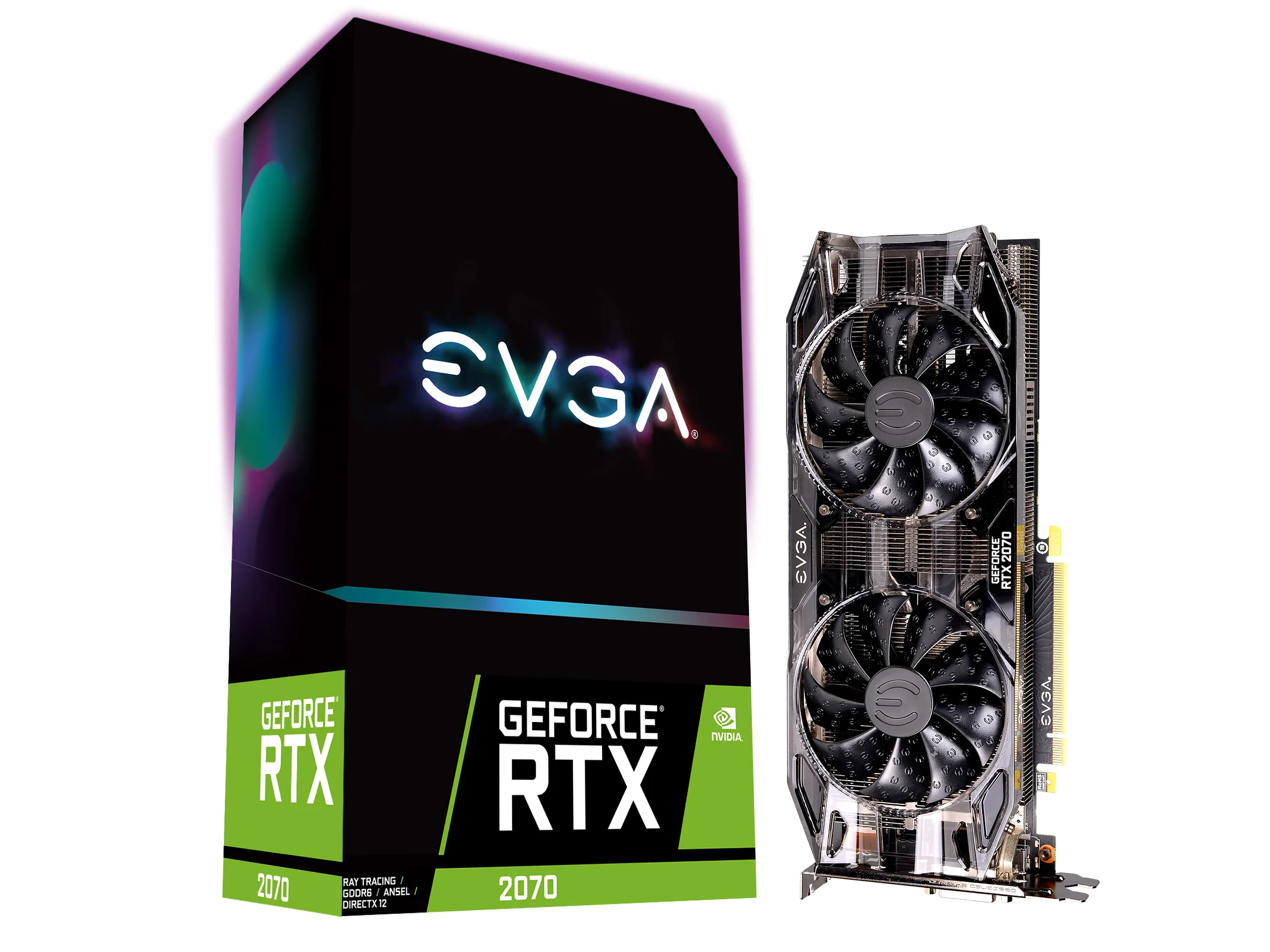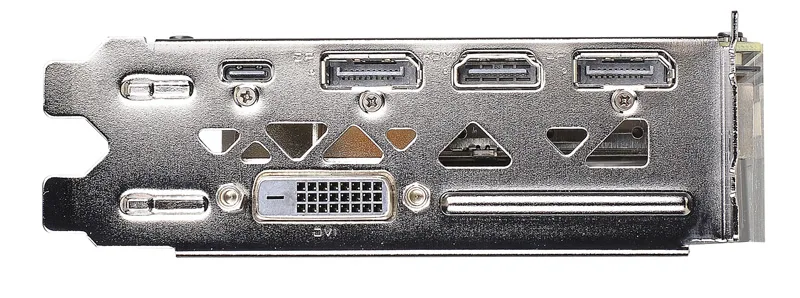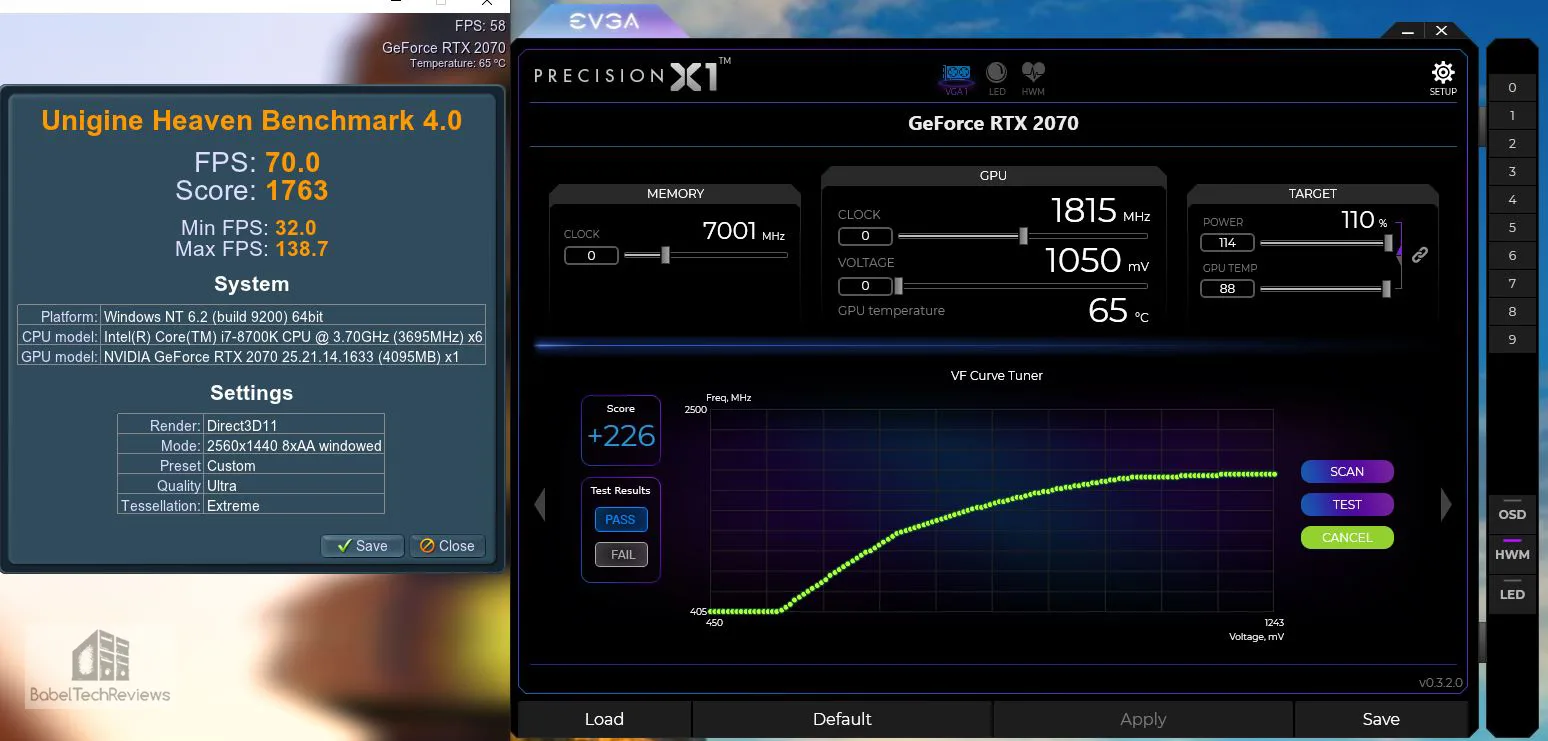The EVGA RTX 2070 Black Gaming Edition Benchmarked with 38 Games
The GeForce RTX 2070 is the third GPU based on NVIDIA’s Turing architecture represented by EVGA’s RTX 2070 Black. The RTX 2070 is similar to the RTX 2080 that we reviewed last month although it is less powerful. It is also considerably less expensive at $499 compared with the GTX 1080 which launched at $699 for entry-level partner cards and at $799 for the reference Founder’s Edition .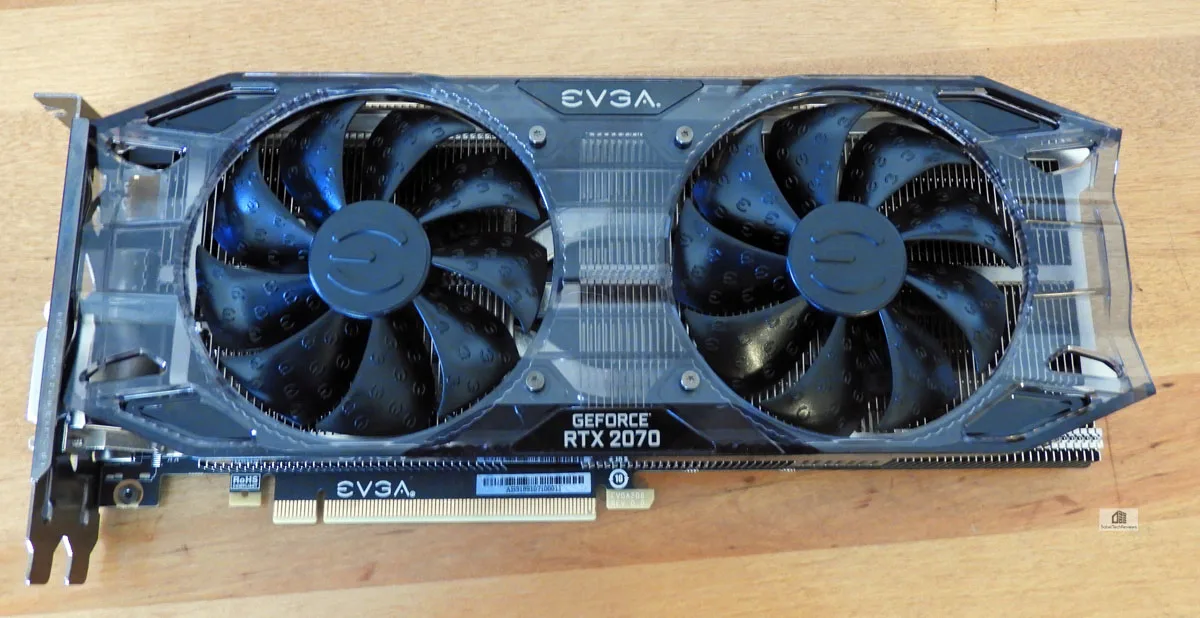
The Black is EVGA’s stock-clocked entry-level RTX 2070 card and it costs $100 less than the built-by-NVIDIA reference Founder’s Edition, and many RTX 2070 versions will be available for purchase tomorrow. The Black’s Boost Clock is at 1620 MHz and EVGA offers 3 other more expensive SKUs that offer up to 1815 MHz Boost for the EVGA RTX 2070 FTW3 Ultra Gaming card.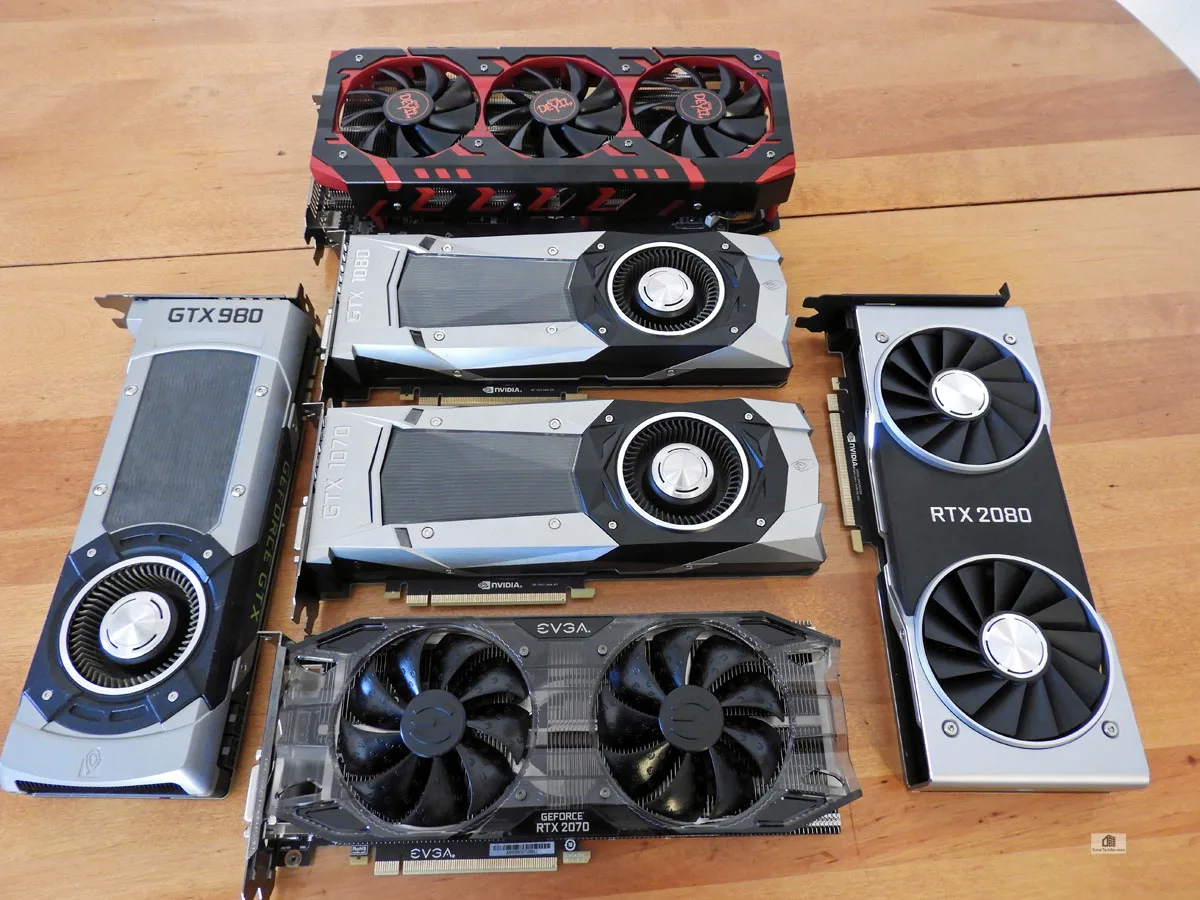
Instead of repeating all of the same information in our RTX 2080 launch review, we will highlight the differences between the RTX 2070 and the RTX 2080, and then we will focus on performance by benchmarking it with a similar but expanded benching suite including Call of Duty: Black Ops 4 and Assassin’s Creed: Odyssey to see how capable it is.
We will pay particular attention to the RTX 2070 Black’s performance versus its main and higher-priced competitor, the $599 PowerColor Red Devil Vega 56, and versus the GTX 1080 which is in the $460-$599 price range. We will also compare its performance with the RTX 2080, the GTX 1070 that it replaces, and will measure how far it has progressed versus the GTX 980, at 1920×1080, 2560×1440, and even at 3840×2160 to see if it is suitable for gaming at 4K.
The RTX 2070 is not based on the same TU104 GPU used in the GeForce GTX 2080, but it uses its own GPU, the TU106. The GeForce RTX 2070 supports all of the same new features that NVIDIA’s Turing architecture brings including RTX ray tracing and DLSS. The EVGA RTX 2070 Black as well as the reference RTX 2070 features 2304 CUDA Cores, 36 RT Cores, 288 Tensor Cores, and a GPU Boost clock speed of 1620 MHz. A Founders Edition version will be offered directly from NVIDIA’s online store that ships with a 90 MHz overclock, and we will review it here by tomorrow morning
The memory 256-bit subsystem of GeForce RTX 2070 uses eight 32-bit memory controllers for 8 GB of 14 Gbps GDDR6 memory providing up to 448 GB/sec of peak memory bandwidth. Pixel shading is handled by 64 ROP Units with a peak Pixel Fill Rate of 109.4 Gigapixels/second for the RTX 2070 Founders Edition and slightly less for the EVGA RTX 2070 Black. The GeForce RTX 2070 has 144 Texture Units that provide a Texture Rate of 246.2 Gigatexels/second. Here is a table illustrating the differences between the stock RTX 2070 and the GTX 1070.

BTR received a RTX 1070 Black from EVGA last week, and for the past three days since we got the launch drivers on Friday, we have put it through its paces using 38 games. We are testing all of our competing cards on a clean installation of Windows 10 64-bit Home edition, using Core i7-8700K with all six cores overclocked to 4.7 GHz by the BIOS, and 16GB of Kingston’s 3333 MHz DDR4.
Key Features of the EVGA RTX 2070 Black
Here is a chart which sums up the specifications, features, and requirements of the EVGA RTX 2070 Black.

EVGA offers a 3 year warranty for the Black Edition that can be extended by registering on their site, and their warranty service is second to none in our experience.
The EVGA RTX 2070 Black Edition Images
We usually perform an unboxing, however, the RTX 2070 Black arrived in a box that EVGA says is not final, so we are using the box image they supplied and some others besides our own.
It’s a relatively large box compared with the Founders Edition boxes, and one corner is notched, probably for artistic reasons and to stand out from the usual rectangular boxes.
Here is the EVGA RTX 2070 Black.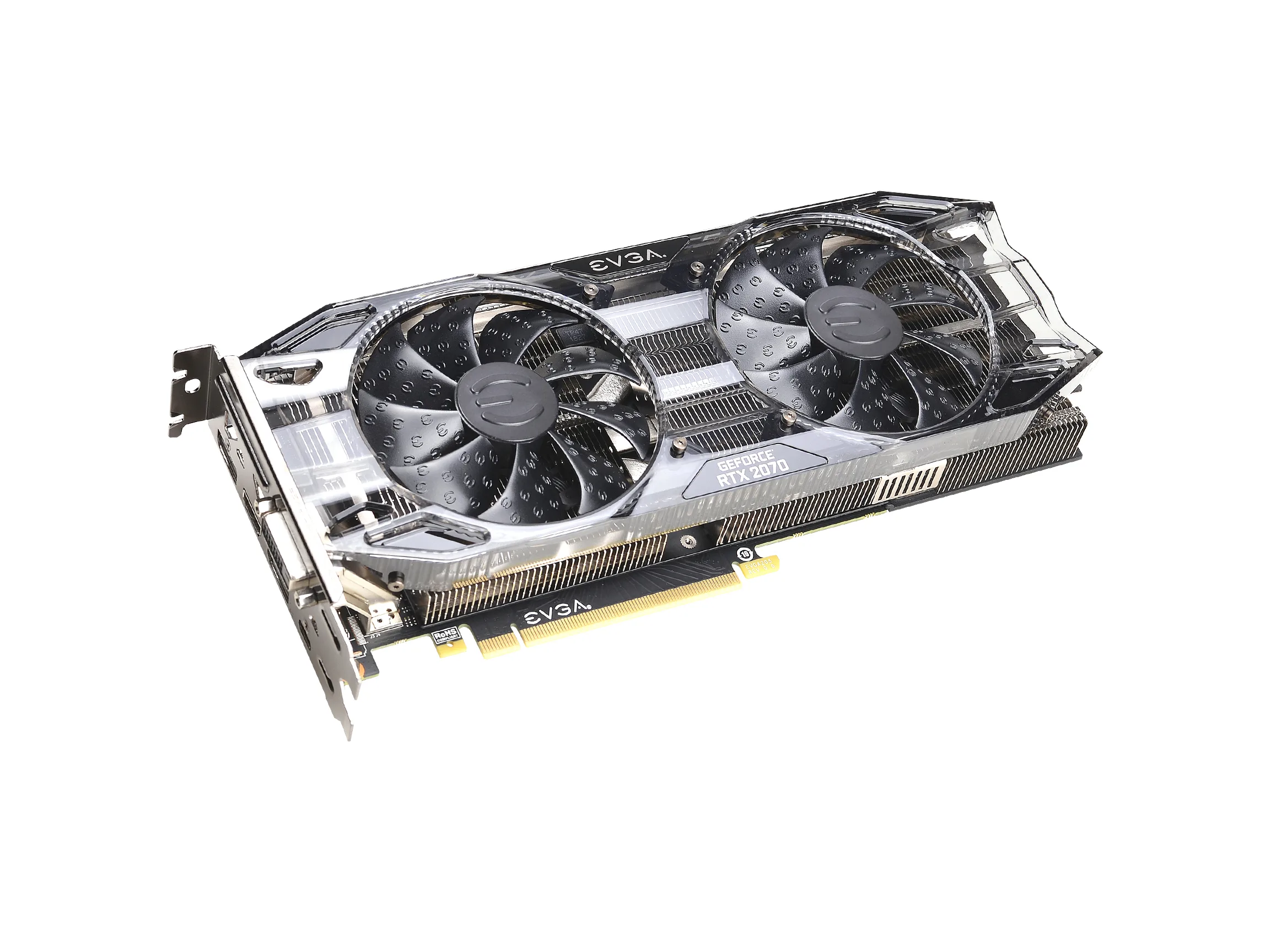
Here it is from another angle.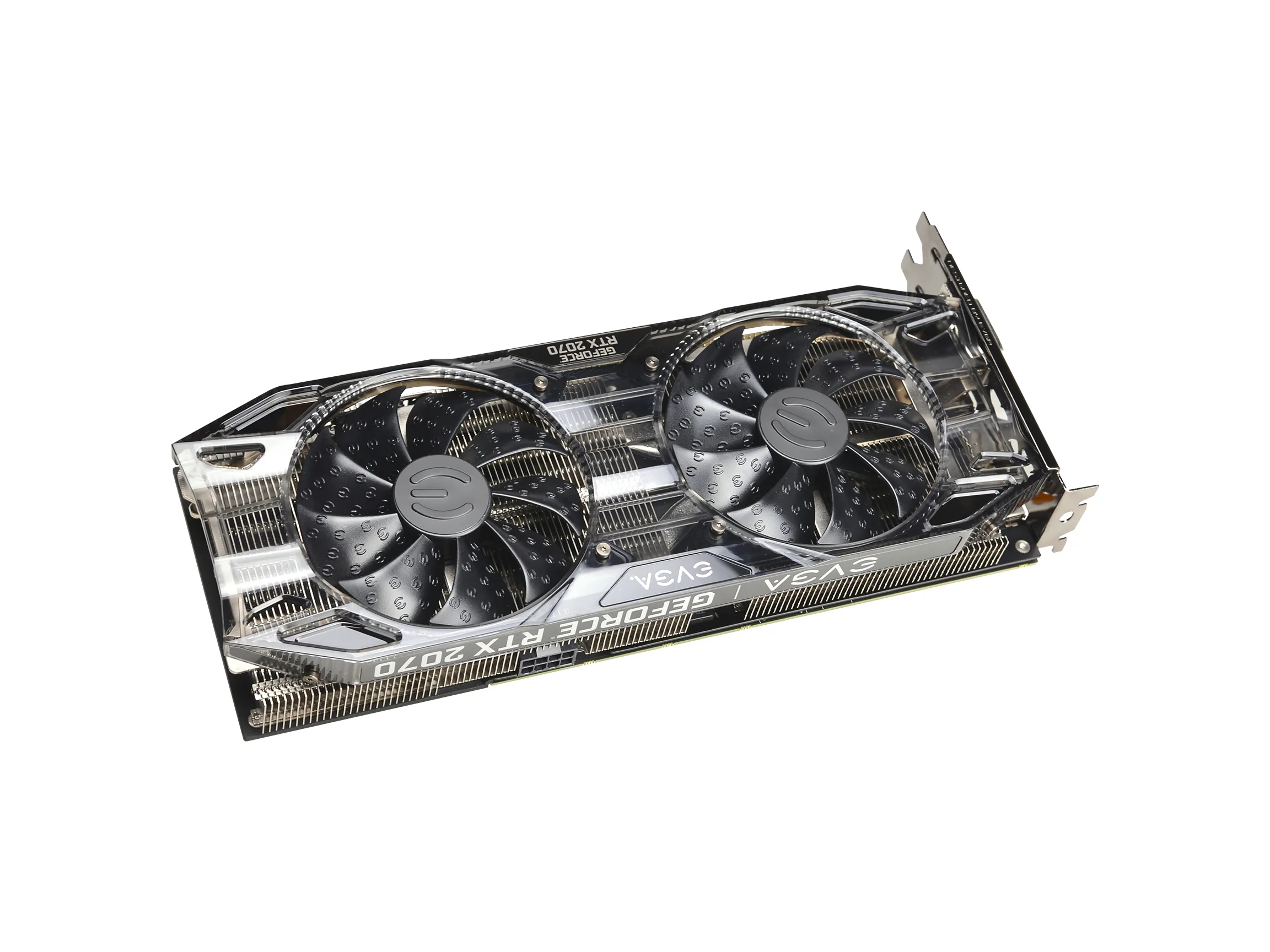
Looking straight down we can see the large heatsink through the fan blades and translucent gray plastic shroud.
Here is the obverse. It doesn’t come with any backplate as befits an entry-level card.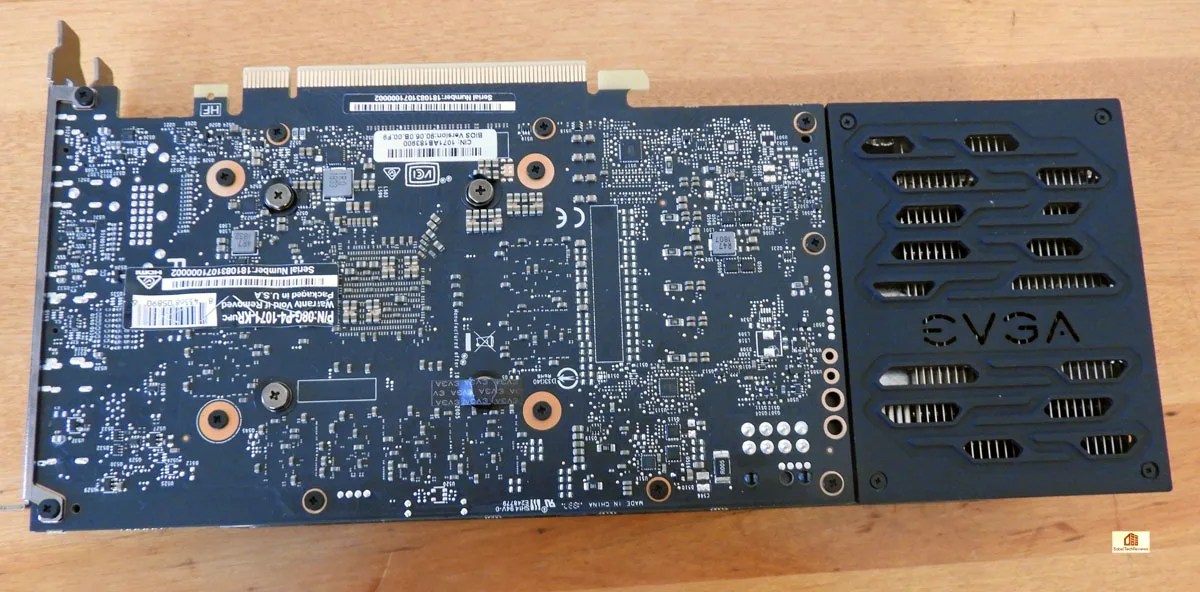
Turning it on its edge, we can see that the EVGA RTX 2070 Black has a rather large heatsinks.
The connectors consist of two DisplayPorts, a HDMI connector, a DVI connector, the new NVIDIA Type-C/VirtualLink connector that may be especially useful for upcoming HMD VR connections, and a DVI port.
It looks great inside of our EVGA DG-77 case but we did not have time to vertically mount it.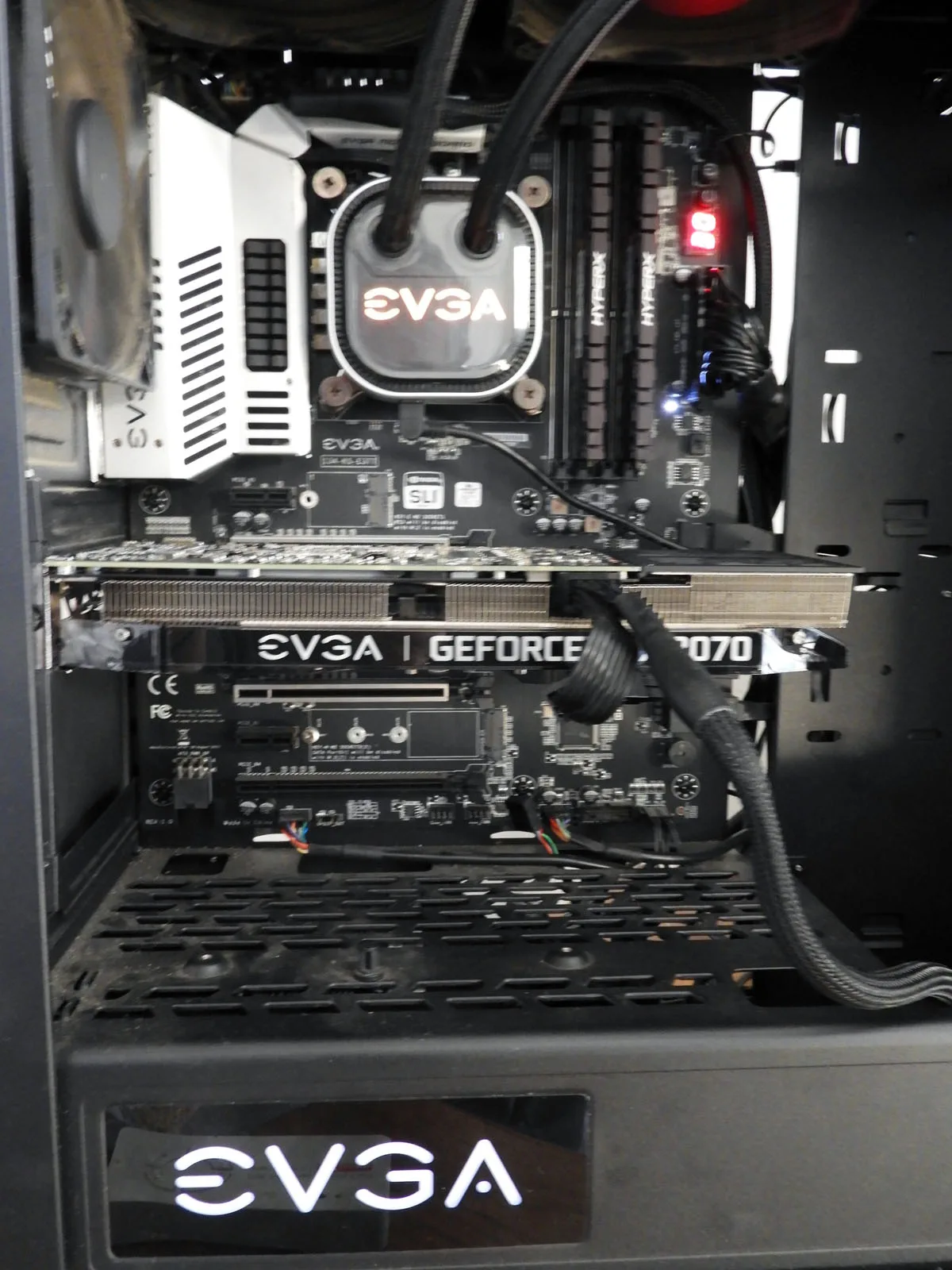
Before we explore overclocking and then performance testing, let’s take a closer look at our test configuration.
Test Configuration – Hardware
- Intel Core i7-8700K (HyperThreading and Turbo boost is on to 4.7 GHz for all cores; Coffee Lake DX11 CPU graphics).
- EVGA Z370 FTW motherboard (Intel Z370 chipset, latest BIOS, PCIe 3.0/3.1 specification, CrossFire/SLI 8x+8x), supplied by EVGA
- HyperX 16GB DDR4 (2×8 GB, dual channel at 3333 MHz), supplied by HyperX
- EVGA RTX 2070 8 GB Black, stock RTX 2070 clocks, supplied by EVGA
- GTX 1070 8 GB Founders Edition, stock FE clocks, supplied by NVIDIA
- RTX 2080 8 GB Founders Edition, stock FE clocks, supplied by NVIDIA
- GTX 1080 8 GB Founders Edition, stock clocks, supplied by NVIDIA
- GTX 1070 8 GB Founders Edition, stock clocks, supplied by NVIDIA
- GTX 980 4 GB, Founders Edition stock clocks, supplied by NVIDIA
- PowerColor RX Vega 56 8GB, at factory overclocked settings, supplied by PowerColor
- 2 x 480 GB Team Group SSDs – one for AMD, and one for NVIDIA
- 1.92 TB San Disk enterprise class SSD
- 2 TB Micron 1100 enterprise class SSD
- Seasonic 850W Gold Focus power supply unit
- EVGA CLC 280mm CPU water cooler, supplied by EVGA
- Onboard Realtek Audio
- Genius SP-D150 speakers, supplied by Genius
- EVGA DG-77, mid-tower case supplied by EVGA
- LG 43″ HDR 4K TV
- Monoprice Crystal Pro 4K
Test Configuration – Software
- Nvidia’s GeForce 416.33 launch drivers were used for the EVGA RTX 2070 Black and the GTX 1070, and 411.51 drivers for the RTX 2080. 416.16 WHQL drivers are used for the GTX 980 and 399.07 is used for the GTX 1080. See Control Panel image below.
- AMD Adrenalin Software 18.10.1 drivers were used for the Vega 56. See Control Panel image below.
- VSync is forced off.
- AA enabled as noted in games; all in-game settings are specified with 16xAF always applied
- Gaming results show average frame rates in bold including minimum frame rates shown on the chart next to the averages in a smaller italics font.
- Highest quality sound (stereo) used in all games.
- Windows 10 64-bit Home edition. All DX11 titles were run under DX11 render paths. DX12 titles are generally run under the DX12 render path unless performance is lower than with DX11. Three games use the Vulkan API.
- Latest DirectX
- All 38 games are patched to their latest versions at time of publication.
- WattMan used to set overclocking, cooling and power options. See Control Panel image below.
- PrecisionX1 pre-release version for RTX settings and for overclocking
- OCAT, latest version
- Fraps, latest version
38 PC Game benchmark suite & 4 synthetic tests
Synthetic
- Firestrike – Basic & Extreme
- Time Spy DX12
DX11 Games
- Grand Theft Auto V
- The Witcher 3
- Fallout 4
- Watch Dogs 2
- Just Cause 3
- Rainbow Six Siege
- Battlefield 1
- Resident Evil 7
- For Honor
- Ghost Recon Wildlands
- Mass Effect: Andromeda
- Prey
- DiRT 4
- Project CARS 2
- Middle Earth: Shadow of War
- Assassin’s Creed Origins
- Destiny 2
- Call of Duty WW II
- Star Wars: Battlefront II
- Final Fantasy XV
- Far Cry 5
- The Crew 2
- Assassin’s Creed: Odyssey
- Call of Duty: Black Ops 4
DX12 Games
- Tom Clancy’s The Division
- Ashes of the Singularity: Escalation
- Hitman
- Rise of the Tomb Raider
- Deus Ex Mankind Divided
- Gears of War 4
- Civilization VI
- Sniper Elite 4
- Total War: Warhammer II
- Forza 7
- Shadow of the Tomb Raider
Vulkan Games
- DOOM
- Wolfenstein: The New Colossus
- Strange Brigade
Additional Demo
- FFXV standalone Demo – DLSS vs. TAA
AMD Adrenalin Control Center Settings:
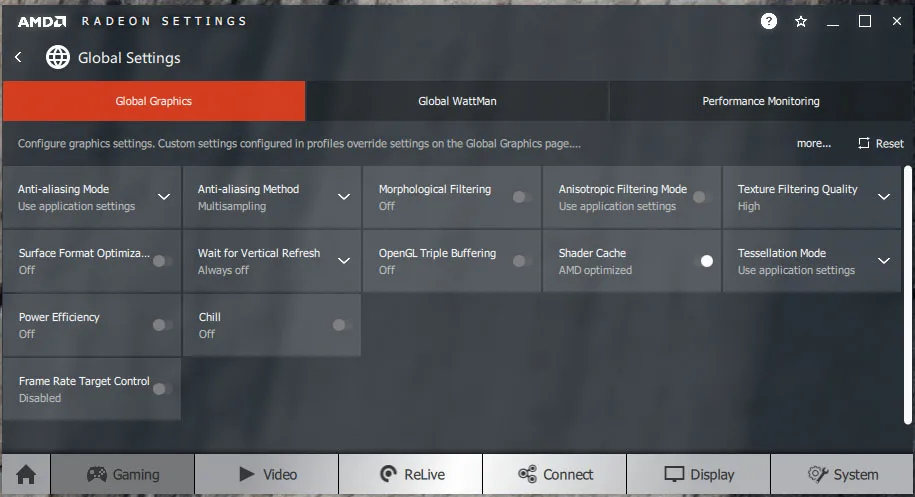 All AMD settings are set so as to be apples-to-apples when compared to NVIDIA’s control panel settings – all optimizations are off, Vsync is forced off, Texture filtering is set to High, and Tessellation uses application settings.
All AMD settings are set so as to be apples-to-apples when compared to NVIDIA’s control panel settings – all optimizations are off, Vsync is forced off, Texture filtering is set to High, and Tessellation uses application settings.
We used Wattman to set the Red Devil Vega 56’s power, temperature and fan settings to their maximums.
NVIDIA Control Panel settings:
Here are the NVIDIA Control Panel settings that match AMD’s settings.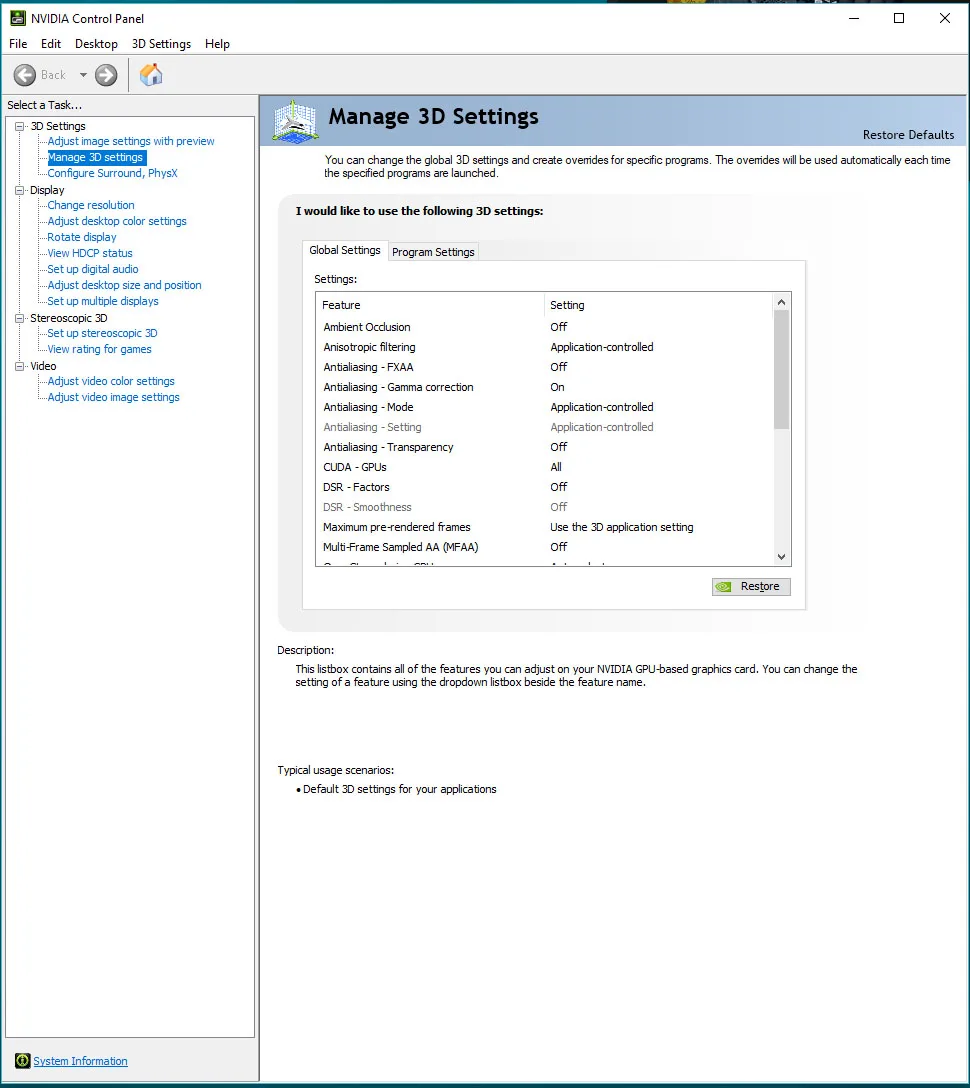
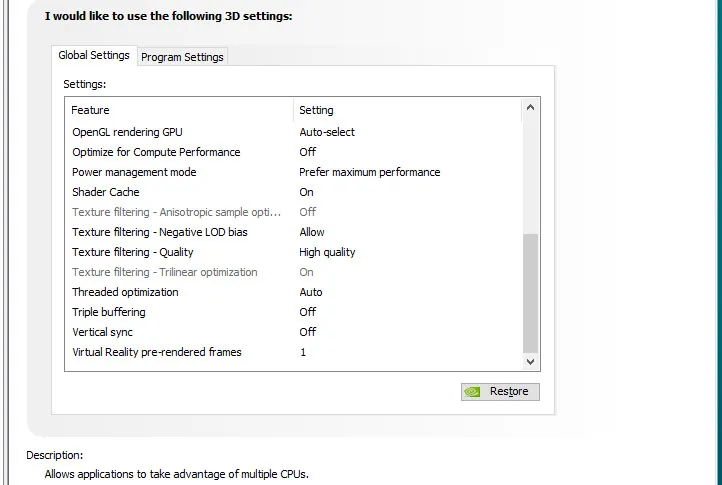 We used the latest unreleased beta of EVGA’s Precision X1 scanner to set all cards’ highest Power and Temperature targets and for our preliminary overclock of the RTX 2070 Black.
We used the latest unreleased beta of EVGA’s Precision X1 scanner to set all cards’ highest Power and Temperature targets and for our preliminary overclock of the RTX 2070 Black.
By setting the Power Limits and Temperature limits to maximum for each card, they do not throttle, but they can each reach and maintain their individual maximum clocks. This is particularly beneficial for high power cards including the PowerColor Red Devil RX Vega 56 edition.
Let’s check out overclocking, temperatures and noise next.
Overclocking using Precision X1, temperatures & noise
The EVGA RTX 2070 Black is a very quiet card even when overclocked. We could not hear the card over the many fans of our PC even when it ramps up. We will spend more time with overclocking in our follow up reviews, but we did automatically overclock the EVGA RTX 2070 Black using the Precision X1 scanner. The beta that we are using is not yet available to the public but should be available tomorrow when the card is released for purchase.
We benchmark all of our video cards with power and temperature targets set to maximum to unleash the cards full performance potential at stock clocks.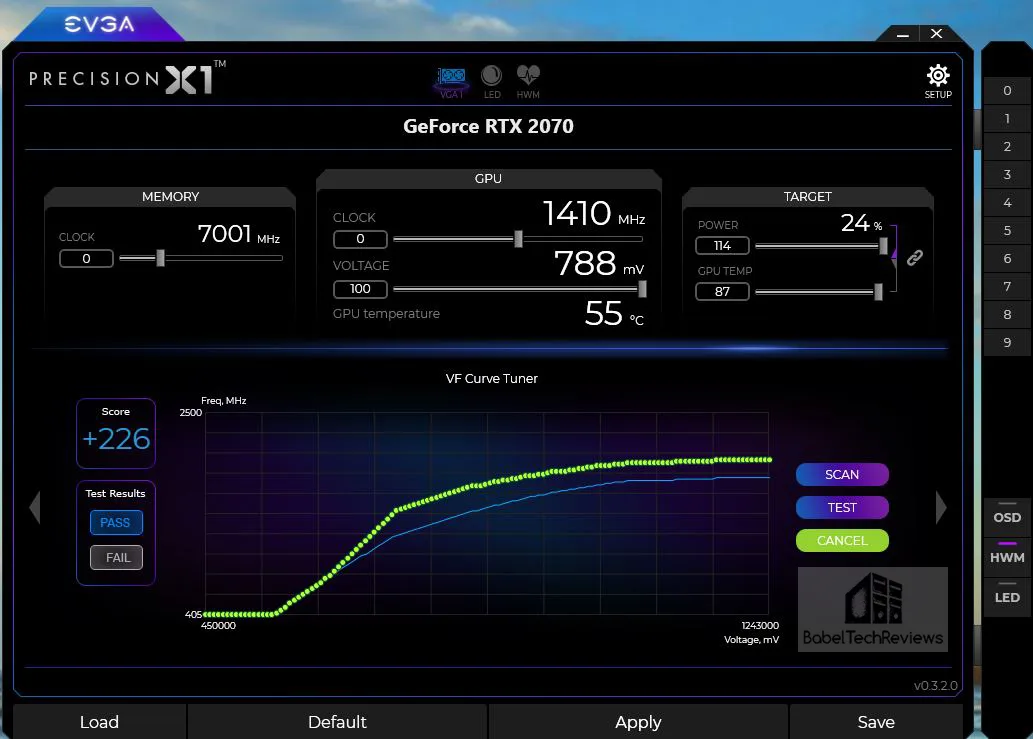
We used the new scanner and it found it to be quite accurate compared with the scanner that released with Pascal. To find the automatic overclock, click on the Scan button and wait for about 20 minutes until it finishes, and then hit “apply”. You can also test the stability of your own overclock by using the Test button.
Precision X1 decided that 1950 MHz to 1980 MHz was the maximum safe overclock, set it automatically, and gave us a score of 225 at default and 226 with the voltage, power, and temperature limits set to maximum. It turned out to be over-optimistic.
At stock settings with temperature and power targets set to maximum, looping Heaven resulted in a cool-running GPU with Boost 4.0 settling in just above 1800 MHz but well above the Black’s 1620 MHz guaranteed boost.
We did not set our own manual overclock but finally added 200 MHz to the core to peg the clocks mostly at 1965 MHz after we pushed the voltage slider to maximum with peak Boost around 1995 MHz with complete stability. We also were able to add +600 MHz to the RTX 2070 Black’s GDDR6 memory clocks. Performance went way up, but temperatures remained in the mid-60s C with the fan speeds maxing under 2200 rpm.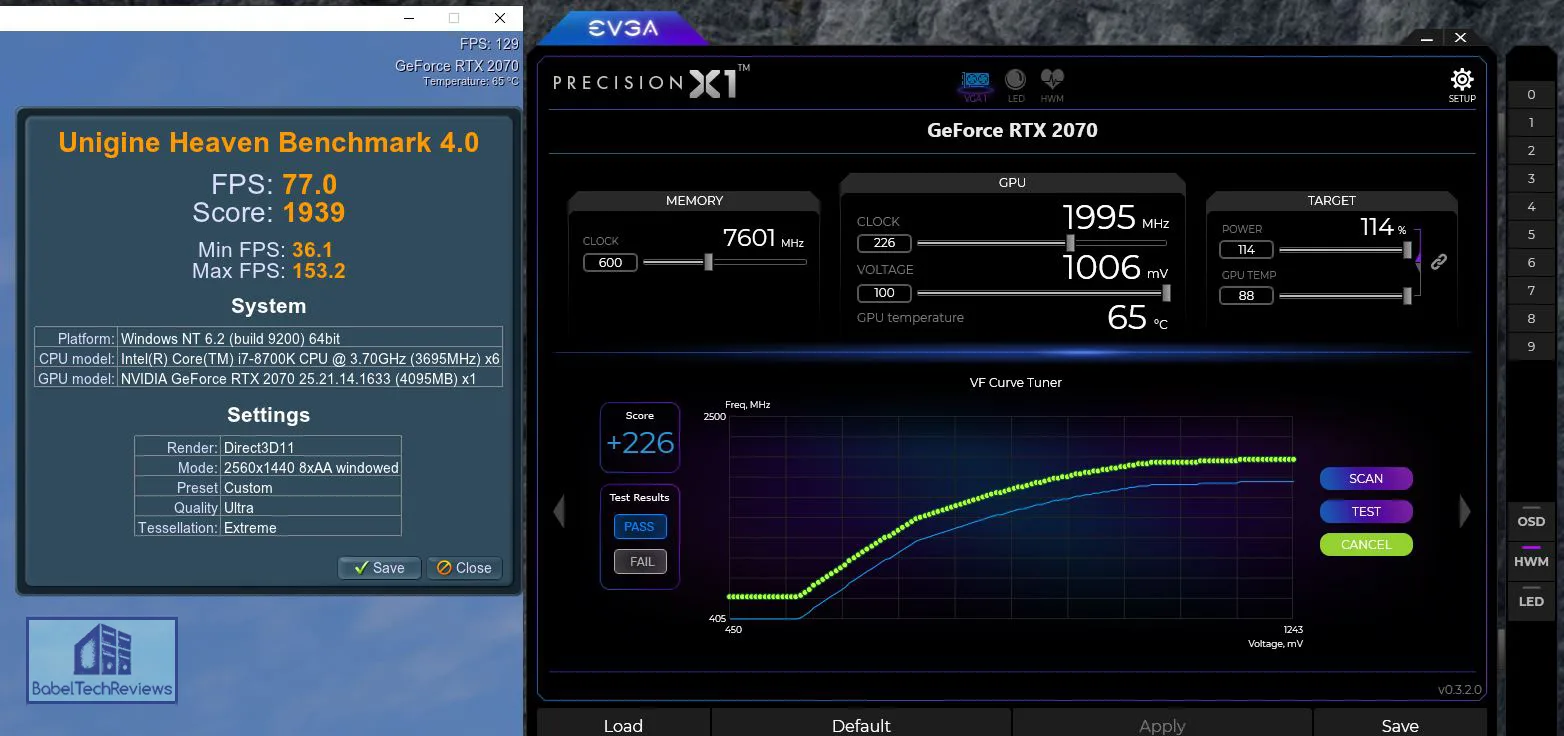
Our preliminary RTX 2070 Black overclock is +200 MHz offset to the core and +600 MHz to the memory while Boost 4.0 varied from a peak of 1995 MHz downward, settling in around 1965 MHz with a low averaging around 1950 MHz.
Our final overclock will be explored later this week when we pit the Black against the Founders Edition and against the GTX 1080. In the meantime, we tested 8 games plus Final Fantasy’s TAA versus DLSS benchmark at 4K resolution to see if our overclock has made any performance difference.
We see several games where an overclock may help to improve a game’s fluidity at 4K. It appears from our very limited time with the RTX 2070 Dark that overclocking is good and similar to Pascal overclocking, but it appears that a 1980 MHz is close to the limit for its cooling and power delivery systems with peak Boost just under 2000 MHz. We also like NVIDIA’s new scanner, and EVGA’s new Precision X1 is much more stable than when it originally released for Pascal.
Let’s check the EVGA RTX 2070 Black’s performance using 38 games and then head for our conclusion.
Performance Summary Charts & Conclusion
Here are the summary charts of 38 games and 2 synthetic tests. The highest settings are always chosen and the settings are listed on the chart. The benches were run at 1920×1080, 2560×1440, and at 3840×2160. Six cards were benchmarked for this review and they are listed on the charts.
Most results show average framerates and higher is better. Minimum framerates are next to the averages in italics and in a slightly smaller font. A few games benched with OCAT show average framerates but the minimums are expressed by frametimes in ms where lower numbers are better.

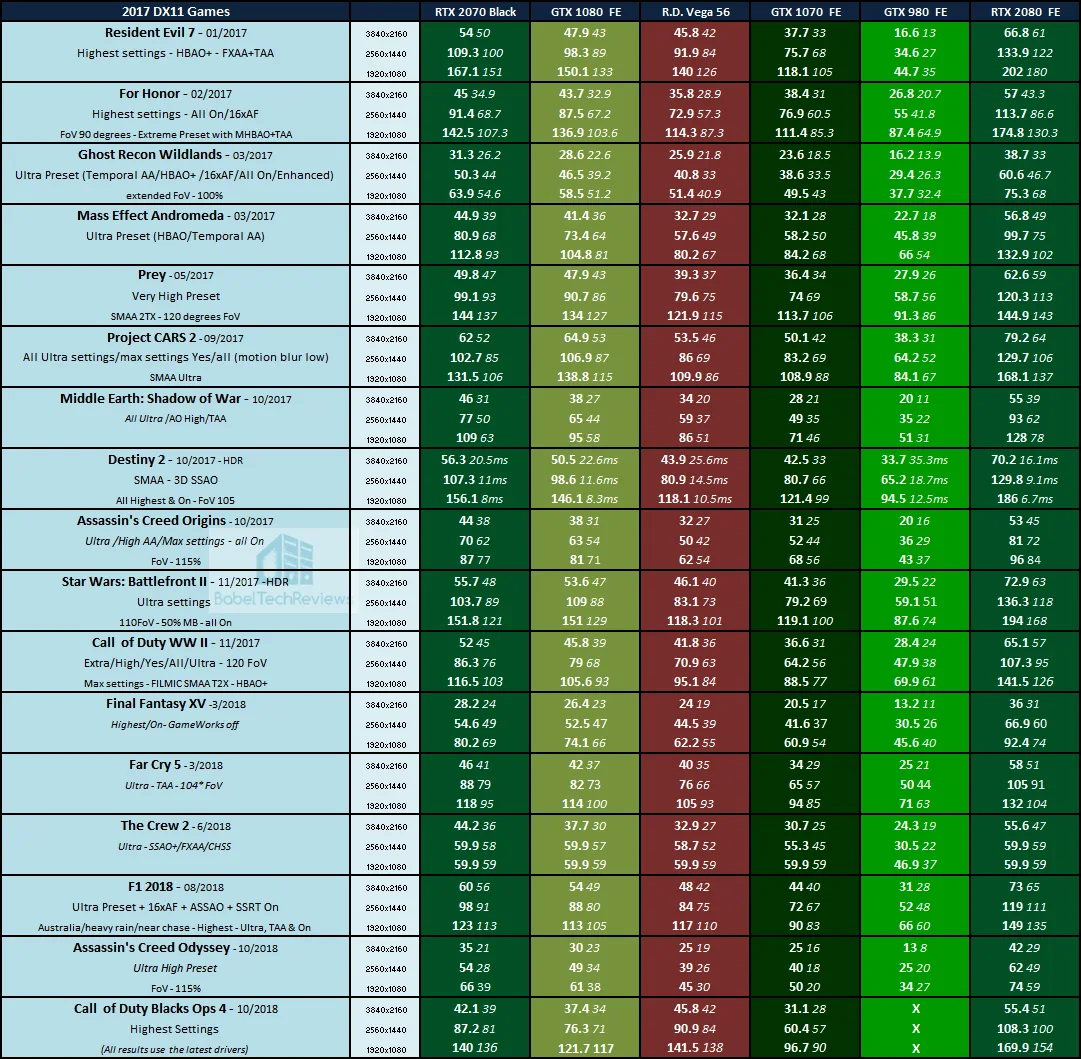


The Big Picture
The following chart is what BTR calls its “Big Picture”. The following chart uses the same performance numbers but places them into a much larger benching suite with a total of 12 cards As always, open the individual images into separate tabs or windows for easier viewing.

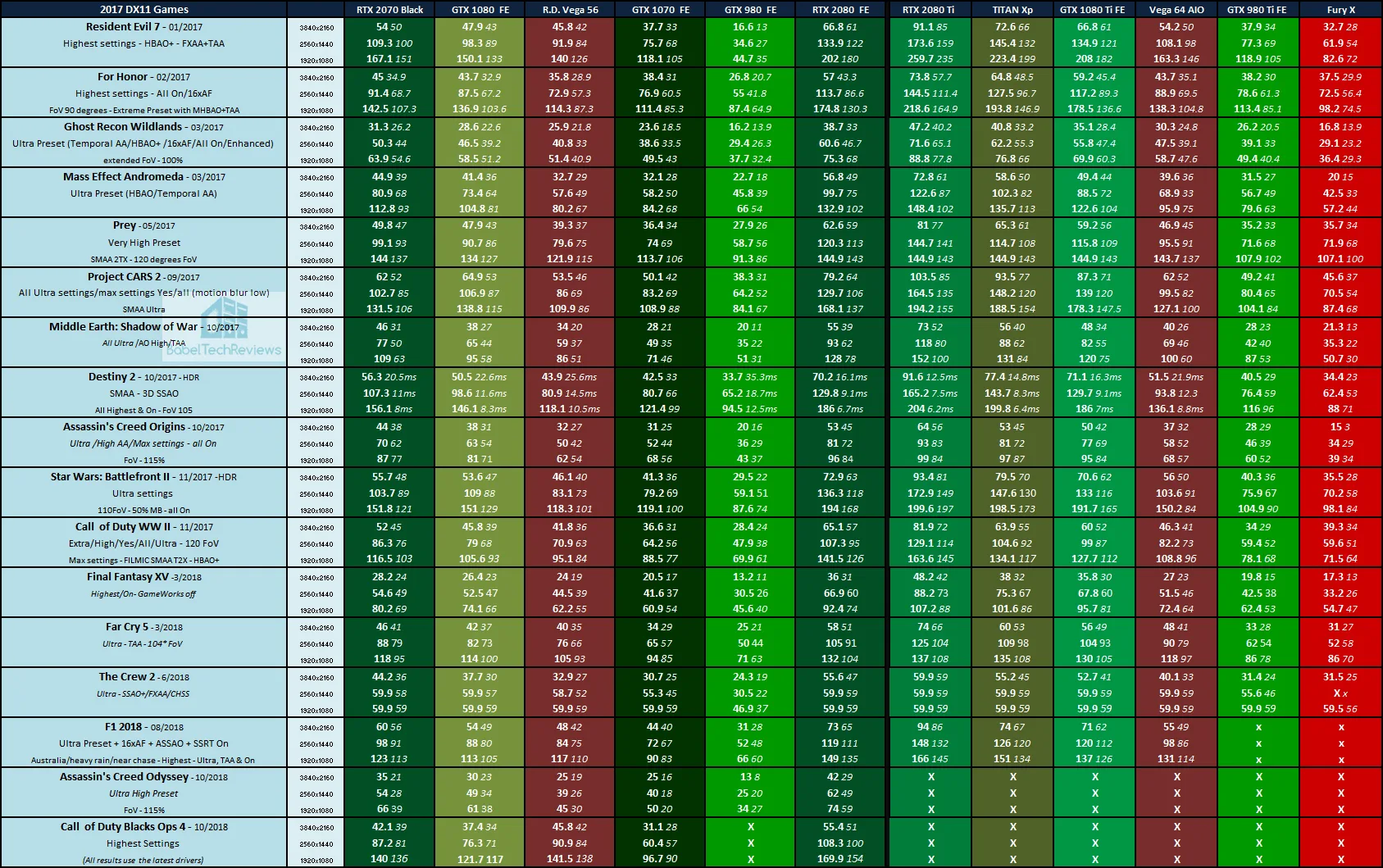


It is a blowout and the $499 entry-level EVGA RTX 2070 Black wins almost every game benchmark over the $599 premium Red Devil RX 56 and also over the GTX 1080 by solid margins although it falls short of the much more expensive RTX 2080. Surprisingly, the RTX 2070 is also suitable for 4K using Ultra/High settings for many games.
The RTX 2070 is much faster than the GTX 1070 which launched at $379/$459 that it replaces and there is no comparison with the GTX 980, never mind the GTX 970 which we did not test. The EVGA RTX 2070 Black would be an excellent upgrade from an older card without even considering future RTX or DLSS implementation.
Let’s head for our conclusion.
This has been quite a hectic but enjoyable weekend exploration evaluating the new Turing EVGA RTX 2070 Black. It did exceptionally well performance-wise compared to either the similarly priced GTX 1080 or to the premium Red Devil Vega 56 that costs $100 more.
Although NVIDIA is betting their gaming future on introducing RTX, DLSS, and ray tracing, we didn’t have to consider them but are basing our conclusion on performance alone. Future DLSS and ray tracing implementation into games are just icing on the RTX 2070 cake.
Conclusion
We are totally impressed with this high-performance single 8-pin PCIe cabled Turing RTX 2070 Black that has such great performance even at ultra 4K. The entry level EVGA RTX 2070 Black is priced at a reasonable $499 and it is faster than either the GTX 1080 in a similar price range or the $599 premium Red Devil RX Vega 56.
The EVGA RTX 2070 Black is well-built, solid, and good-looking, and it is easily overclocked; in our case, 200 MHz over stock clocks with also a very good performance enhancing 600 MHz offset to the GDDR6. Our follow-up overclocking showdown between the RTX 2070 Black and the Founders Edition versus the GTX 1080 will explore overclocking further.
Pros
- The RTX 2070 Black is a very fast card that performs better than a similarly priced GTX 1080 or a much more expensive premium Vega 56.
- The RTX 2070 Black is priced similarly to the GTX 1080 but has new features and it is faster. It is also $100 less expensive than its weaker competitor, the Red Devil RX Vega 56.
- Ray tracing is a game changer in every way and a leap forward over rasterization.
- Turing brings AI/deep learning and ray tracing to improve visuals while also increasing performance with DLSS.
- Overclocking headroom is very good – GPU Boost 4.0 works with the Precision X1 scanner utility to quickly set an automatic overclock.
- The EVGA RTX 2070 Black’s design cooling is quiet and efficient; the card and well-ventilated case stay cool even when highly overclocked.
- EVGA offers a 3 year warranty with a further extension upon registering.
Cons
- None
The Verdict:
 If you are buying a very fast video card
If you are buying a very fast video card  right now and looking for good Ultra/High 4K performance, the EVGA RTX 2070 Black is an excellent choice. It is a high performance card to run in 4K and VR systems. The RTX 2070 Black is faster than the GTX 1080 at a similar price or the more expensive premium Vega 56, and it has newer features.
right now and looking for good Ultra/High 4K performance, the EVGA RTX 2070 Black is an excellent choice. It is a high performance card to run in 4K and VR systems. The RTX 2070 Black is faster than the GTX 1080 at a similar price or the more expensive premium Vega 56, and it has newer features.
We would like to award the EVGA RTX 2070 Black BabelTechReviews’ Editor’s Choice Award and our Good Value Award. Turing brings important new features to PC gaming to improve both performance and visuals which we consider the icing on the cake.
The RTX 2070 brings a superb and reasonably priced high-performer to the GeForce RTX family. With great forward-looking features, you can be assured of immersive gaming by picking this card for 1440P, 4K, or for VR.
If you currently game on a lesser video card, you will do yourself a favor by upgrading to a EVGA RTX 2070 Black video card. It will give you better visuals for ray tracing, and DLSS will allow for better performance for the games that will use it.
We also have received a Founders Edition of the RTX 2070 which is $100 more expensive than the EVGA RTX 2070 Black and we will post our evaluation tonight.
Stay tuned, there is a lot coming from us at BTR. We will shortly test the RTX 2070 Founders Edition and RTX 2070 Black in an overclocking showdown this week versus the GTX 1080. Next week, we hope to finally benchmark the Vive Pro and the Oculus Rift with the top RTX, Pascal, and Vega cards.
Happy Gaming!
